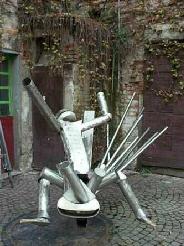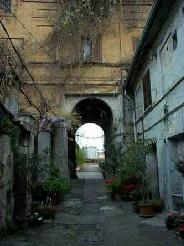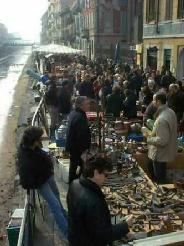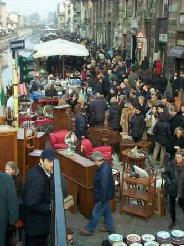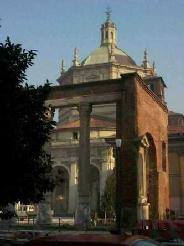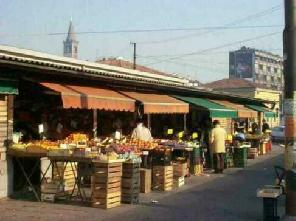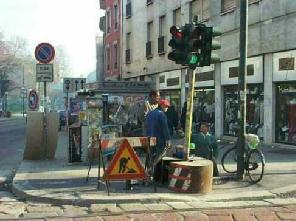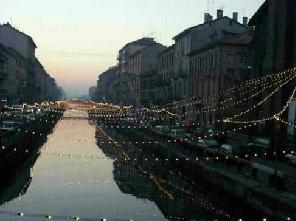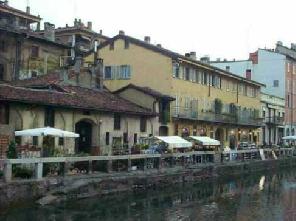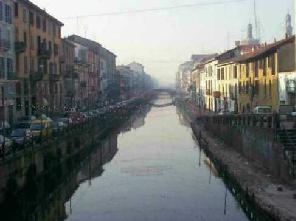Milano (Milan) - Photo Gallery 01 Gallery 02 Gallery 03
Gallery 04 Gallery 05 Gallery 06
|
Adding new photographs of Liguria,
the Italian Rivieras and Italy every month. |
Milano, Province of MILANO
Palaces and Entrances
Milan’s magnificent past is preserved well: from proud examples of the Renaissance’s artistic and cultural fervor to the extravagances of the Belle Époque. Its eclectic architecture, open to all influences, reflects a vitality and an exceptional creative impulse. Even though the Milanese have always paid more attention to interior decoration than external structure, the city has palazzos (palaces or large homes), façades, and portals of remarkable beauty. The discovery of some of these gems starts with the 17th century Palazzo di Brera, a former Jesuit college, now an art academy, library and art museum that are among the most important in Italy (from its windows, admire the exotic plants in the Botanical Garden below, created by Maria Theresa of Austria in 1774.) Then there are the palaces where the 18th and 19th century elite gathered for their many social and cultural occasions: the elegant Palazzo Clerici, Palazzo Trivulzio (now the Poldi Pezzoli Museum) and Palace Museum Bagatti Valsecchi with its quaint neo-Renaissance style. In the nearby Porta Venezia area, visit Villa Reale, Casa Fontana Silvestri and Palazzo Serbelloni. On via Malpighi and via Pisacane are some of the most recent, but no less delightful, examples of Art Nouveau: look up at the floral decorations, mosaics, portals and balconies in wrought iron and carved stone. The Art Nouveau trail ends between corso Monforte and via Bellini with buildings by famous architect Campanini. Continuing on, note the severe tone of 15th century Casa Parravicini and the Rococo splendor of Palazzo Bolaños, concluding the itinerary in Piazza dei Mercanti to admire the 16th century Palazzo dei Giureconsulti.
Charming Navigli
Its river-city spirit is still alive today thanks to its waterways called navigli. Although occasionally covered by asphalt, they continue to feed the spirit while waiting for the next rebirth. Over the centuries, the Lombard capital has been a point of destination and departure for countless sailors and scores of boats carrying all sorts of cargo (including marble for our Duomo). Walking along the banks of the canals is a fascinating adventure.
In 1979 the last cargo boat tied up at the Darsena, or docks, of Porta Ticinese. And so ended a long story, one that had begun eight centuries before. Back in the 1200s, the city aspired to connect with the sea by joining up with the Po, the great river of the fertile north-central plains. The dream gained strength when Galeazzo Visconti ordered a naviglio, or canal, to be built connecting Milan to Pavia. Over the centuries, traffic increased and by 1953 the Darsena was the 13th most important port in Italy. Then it gradually declined, until its recent rebirth. Today the Canals are a Milanese landmark, a place of both nostalgia and innovation, an artsy quarter and a hopping nightlife scene. This walking tour of the Navigli district (which includes Naviglio Pavese and Naviglio Grande but not Naviglio della Martesana which is farther out) has a short version and a long one (that can be done with the help of the tram). The long route starts at the Church of S. Eustorgio where new archbishops from the Diocese of Milan (the biggest in the world) are received. Don’t miss the famous Portinari Chapel inside. The tour continues on corso di Porta Ticinese and then along the Navigli, lined with renovated historic buildings where artists and intellectuals now live, brimming with both old-fashioned and inventive cafes, shops, bars and restaurants that come to life especially in the evenings and weekends. Check out national historic site Vicolo dei Lavandai with its old stone washboards and rustic wooden shelter, and (in the long version) the Church of S. Cristoforo whose 15th century bell tower was once considered Milan’s lighthouse, signaling to arriving barges the journey’s near end.
Cloisters and courtyards
A multi-faceted city where eloquent vestiges from the past live alongside new creative workshops. To experience this, just linger on the little streets in the Medieval heart that are dotted with Roman remains. Moving toward the Baroque and Neoclassical center, observe delightful Art Nouveau palaces or imposing examples of Rationalism. A journey for both soul and mind.
Full of atmosphere, they are one of Milan’s richest assets. Along with the most famous, there are many splendid and little-known ones to be discovered. They are cloisters of ancient convents that the city was once bursting with (before Napoleon ordered the dissolution of religious orders), and the courtyards of both luxury aristocratic palaces as well as modest but distinctive ringhiera apartments with their rings of external railings. This itinerary highlights over 20 of these treasures in the most central areas of the city dating back to a variety of eras. In no logical order, 14th century cloisters and 20th century courts follow one after another from door to door. Similarly, this route proceeds from the 15th century cloisters of Umanitaria and of the old Ospedale Maggiore (General Hospital), now the main campus of the University of Milan, to the 17th century ceremonial court of Palazzo Durini and the 18th century courtyard of Palazzo Morando Attendolo Bolognini. Winding through the center of town to the Brera neighborhood, don’t miss the Cloisters of S. Simpliciano and the courts of some of the most famous palaces of the 18-19th century, which alternate with the characteristically Milanese working-class buildings of corso Garibaldi. The Magenta neighborhood, only a few stops away on the subway, is just as rich in history and unique architecture. Take a look at the courtyard of via Toti 2, where Lombard and Austrian influences (in the tradition of Loos) blend perfectly. Like Brera’s via Borgonuovo, corso Magenta and via Cappuccio are full of jewels, such as Palazzo Litta and Bramante’s little cloister in S. Maria delle Grazie. Finally, visit Bramante’s double cloisters, now seat of the Catholic University, and the courtyard of the beautiful Basilica of S. Ambrogio.
Fashion and Design
Milan is the world capital of style. With more than 600 showrooms, thousands of display windows scattered across the city, expos, talented designers and stylists and wonderful craftsmen, Milan has been able to capitalize on fashion and design and create precious resources for the entire country. This is why we support the fashion industry so that Milan can become an even more beautiful, interesting and exciting place. All for you to discover.
Milan has a central role in the Italian industry of fashion and design, a role it has won over the years thanks to the excellence of its protagonists and a policy of investment and development. The result is that today it is unarguably, not only the Italian, but the European capital of both sectors. Its fashion show calendar is booked solid with dates. Most are presented at the Fiera, but not all (the imagination of designers is limitless). The most important fashion houses introduce their new collections, and open sparkling flagship stores in the so-called Quadrilateral of Fashion. Many labels launch showrooms designed by famous architects, like Tadao Ando for Giorgio Armani or Marco Zanuso for Gianfranco Ferrè, in the most “in” parts of the city: Brera, Navigli, Porta Genova and the city center. The world of design has also carved out a prominent niche for itself. Headquartered in Milan are important exhibition spaces like the Triennale, educational centers like the School of Industrial Design (autonomous branch of Politecnico’s School of Architecture) and the Istituto Europeo di Design, cultural magnets that attract students from all over the world, fostering an atmosphere of creativity and a continuous debate. And every spring the Salone del Mobile, besides a limelight moment for interior design not to be missed, is linked with shows that bring the entire city to life for ten days; in only a few years, spaces designed to host impromptu events, like SuperStudio Più, have become permanent reference points.
Signs and artisan workshops
Milan and work. A telling pair from the start, no matter how the eclectic Milanese dynamism expresses itself each time. Today, fashion, design, communication and finance have captured the limelight. However, the old craftsman skills have not completely been forgotten, now intermixed with various new and ethnic infiltrations. You can still find delightful enclaves of artisan workshops in Brera and Isola, neighborhoods connected by the bustling stores and boutiques of corso Garibaldi. Brera, closer to the historic city center, was the core of 19th and 20th century Milanese cultural life. One of the best-preserved parts of old Milan, its heart is the tangle of streets that surround the Church of S. Maria del Carmine. Isola, together with the Garibaldi area, is a formerly working class neighborhood that is taking on a new identity, filling up with imaginative shopping and nightlife spots. This walking tour is thus a travel back in time: antique signs like Poste e telegrafi on via dell’Orso, or Antica Farmacia di Brera on via Fiori Oscuri, and new initiatives like jewelry workshop Uroburo on via Pepe, where a well-known sculptor teaches disadvantaged kids how to create art objects. It is also a collection of skilled workshops where food items (like fresh bread and pasta), bookbinding products, light sculptures, stained glass, picture frames, leather goods, decorating accessories and precious fabrics are designed and sold. All concentrated in just a few square meters. Tiny factories where you can see creativity taking shape.
Mozart in Milan
Mozart, chaperoned by his father, came to Italy three times between 1769 and 1773. Every time he stopped for rather long periods in Milan (then part of the Hapsburg Empire) winning ever more prestigious jobs despite his very young age. Maria Theresa of Austria commissioned him to write an opera for the wedding of her son, Archduke Ferdinand, celebrated in our city: the serenata Ascanio in Alba, which was a big hit (libretto by the famous abbot Giuseppe Parini). The relationship between Mozart and Milan was thus intense and flourishing. But which Milan did Mozart see and get familiar with? Naturally, 18th century Milan, especially the area between piazza Cavour, piazza della Scala and piazza del Duomo. Today that Milan has mostly disappeared, but not all of it. For example, the first time the 14-year old Austrian musician arrived in the city, he was hosted by the Augustinians (whose monastery is now the Church of S. Marco) in the guest quarters of the residence. He also lived on Duomo square and worked in the nearby Ducale Theater (next to the present Palazzo Reale). Some of his most important compositions were played many times with enormous success in the Duomo and the churches of S. Maria del Carmine and S. Fedele, with Mozart himself directing several masses. The houses where he spent the most time were Palazzo Clerici and the now gone Palazzo Melzi, residence of Count Firmian, the Austrian minister plenipotentiary. Finally, the master himself probably played the organ that still exists in the church of S. Antonio Abate. Those wishing to go into more depth, consulting documents as well as historical images, should visit the Ambrosiana Library (piazza Pio XI 2), Bertarelli Print Collection and Museum of Musical Instruments (inside Sforzesco Castle at piazza Castello). A curiosity: the musician’s son, Karl Thomas Mozart, who lived and died in Milan, is buried at Monumentale Cemetery.
Churches and Chapels
A city that displays for example a legacy of uncommon allure and variety: churches and chapels, like S. Carlo or S. Stefano, the basilica of S. Vincenzo in Prato, the chapel of S. S. Giovanni Di Dio and Vincenzo de’ Paoli, in addition naturally to the Duomo and the other masterpieces indicated in this itinerary. Which brings to mind that Milan is also rediscovering its rich patrimony of antique organs. A city therefore that reveals its cultural roots by remembering the legacy of a long and intricate historical and urban development.
The variety of styles and the artistic-cultural heritage of Milan’s churches is beyond compare: in the historic center alone one can admire splendid realizations of every architectural order, from the majestic and fundamental Romanesque of the basilica of S. Ambrogio, to the moderate but rigorous Baroque of S. Alessandro, to the harmonious Renaissance forms of S. Maria delle Grazie. This enormous heritage also includes important examples of the Neoclassical style, of which Milan is undoubtedly the Italian capital, like S. Maria della Consolazione. But it is not only the architectural value that makes this itinerary interesting: the contribution of great artists of the caliber of Leonardo da Vinci, Bramante and Luini have made the churches of Milan, like S. Maurizio on corso Magenta, and their numerous chapels, into authentic museums. Real treasures of art history are often preserved inside apparently modest structures and in some cases are unknown to the Milanese themselves. Therefore, our itinerary, which begins at the historic corso Garibaldi, takes into consideration several famed churches, but is especially devoted to discovering the many hidden treasures guarded by our city. After a dutiful visit to S. Maria delle Grazie and S. Ambrogio, the tour takes in the chapel of S. Aquilino inside the complex of the basilica of S. Lorenzo, the church of S. Maria dei Miracoli next to the very old S. Celso, and includes the delightful and half-hidden S. Sepolcro with its fantastic crypt, S. Satiro and the Pietà Chapel from 800 A.C., and S. Bernardino with its very curious ossuary. Don’t miss the Baroque jewels: the monumental S. Maria della Passione on via Conservatorio and S. Maria della Sanità on via Durini.
Waterworks
Milan’s past, its origins and its richness are deeply tied to the waterways that allowed it to act as the connecting link between the lakes, where many raw materials were found, and river or marine cities where finished products were sent. But there is a thread that still connects past and present: water as a resource for its aesthetic value. Certain squares for example attract thousands of tourists for the water gushing from their extraordinary fountains that make our city richer and more beautiful.
Milan has always had a strong bond with water, marked by aesthetics and historical place names: at the center of a close net of navigable canals and spread over a vast aquifer, or water-bearing stratum, the city was a charming web of streets and canals only a century ago. The docks and locks designed by Leonardo da Vinci are precious witness to these times: one can still admire the Conca di Nostra Signora lock, on Via Conca del Naviglio, built in honor of the Duke of Milan Ludovico the Moor and the Conca dell’Incoronata lock at the Ponte delle Gabelle bridge. The interest in water—and at the same time hydraulic energy, irrigation and means of transport—is evidenced by sections of the Museum of Science and Technology, which display numerous exemplars of machines, devices and model ships. The memory of the past is also kept alive by the many wells that at one time were supplied directly from the aquifer and that still survive today, hidden in the courtyards of the most secret Milan (like at Corso Buenos Aires 1). We must not forget, in conclusion, that water is also used for purely aesthetic purposes: Milan is full of pools and fountains of outstanding artistic value that are quite unknown. At one time considered a mark of social standing, the gentle symphony of their bubbling cheered the gardens of many elegant homes: one can take a peek at several through the entry doors and gates of Corso Venezia. Alongside historic fountains (public and private) like the Piermarini Fountain or the old sanctuary of Santa Maria alla Fontana, built near a spring said to be miraculous, are more modern ones planned as installations of urban art. The Fountain of Sforzesco Castle is particularly famous, commonly known as the Wedding Cake.
Literary Sites
Milan is a surprising metropolis. To appreciate it, simply leave your watch at home and wander off from the obligatory routes, the usual circuits. If you would like some advice, linger on the streets of literary Milan, retrace the steps of Leonardo, Manzoni, Stendhal, Marinetti. Or “lose yourself” among the noble palaces and artisan workshops, along the banks of the Navigli canals, or amidst the Art Nouveau and Rationalist architecture. And then, discover historic bars and restaurants and the numerous exhibition spaces where artists from all over the world show their works, tell their stories.
Starting point and crossroads of various artistic and literary movements, Milan has always interested men of culture. For the entire 18th century—together with Venice, Florence, Rome and Naples—it was an obligatory stop on the so-called Grand Tour d’Italie, the journey that represented a sort of initiation into adulthood for young European aristocrats. In the second half of the century, Milan became a major center of the Enlightenment and a literary salon of undisputed importance. Milan then became not only the subject of many travel accounts, but also the backdrop for novels and stories. Writers in the 19th century speak of Milan, like Ugo Foscolo in the Last Letters of Jacopo Ortis and Alessandro Manzoni who, in the intense pages of I Promessi Sposi (The Betrothed), describes city life in the 1600s under Spanish domination. Alongside them is a extensive list of visiting foreign authors: Stendhal, George Byron, Charles Dickens, Mark Twain, and Henry James. The following century welcomed Hesse, Kafka and Hemingway, who depicted the city center in a celebrated passage of Farewell to Arms (1929). Ushered in by the futurist movement founded by Filippo Tommaso Marinetti, the 20th century witnessed more leading figures in poetry and literature, like Salvatore Quasimodo, Eugenio Montale and Dario Fo (all Nobel prize winners), Carlo Emilio Gadda, the most famous Milanese author, and paragon for writers of the neo-avantgarde, Giorgio Scerbanenco, father of the Italian-style mystery novel, or more recently, Andrea Pinketts, young and surreal innovator of the hard-boiled detective story. Testimony to the city’s long-standing editorial heritage, important newspapers as well as chief national publishing houses have made their home in Milan, thus fostering the city’s literary and cultural debate.
Parks and gardens
Italy’s second tourist city in terms of daily visitors and expenditures. This is due to the major development of business tourism. The administration’s goal is to strengthen this sector, while at the same time making a concerted effort to develop tourism related to our city’s other important assets: culture, art, gastronomy, recreation, youth, and conferences. Milan offers endless opportunities for diversion: in addition to theaters, cinemas, and nightspots, there are beautiful and large parks.
Milan is greener than it seems at first glance because trees, flowerbeds and gardens are often hidden behind the walls of prestigious private residences, or ordinary apartment buildings, privilege of a few lucky residents. But as early as the late 1700s, the Milanese expressed their need for green spaces for collective recreation. This is how the first Giardini Pubblici on Corso Venezia were born, and then, at the end of the 1800s, Parco Sempione, which occupies a part of what was Parco Ducale del Castello (Ducal Park of the Castle), reserved for the amusements and hunting games of the noble Visconti and Sforza families. These are two vast green stretches, but in the frenetic Milan of business and finance, one doesn’t have to look long to find charming corners, little parks and quiet gardens, now open to the public, that have preserved the rarefied atmosphere of their noble past, like the 16th century Guastalla Gardens, the 17th century Parco Villa Litta in Affori, and the 18th century Gardens of Villa Reale on Via Palestro. The great enthusiasm with which the Milanese have always visited these places acted as a strong incentive for creating new projects in the post-war years: during which time Parco delle Basiliche was created, once a macabre stage for stake pyres and hangings, Parco Lambro, a model of the traditional agrarian Lombard landscape, Parco Formentano on Largo Marinai d’Italia, with its little Art Nouveau palace, Parco Forlanini, which still contains centuries-old farms and old rural dwellings, Parco Montestella, an artificial hill which affords wonderful views of the city and, on clear days, the Alpine Arc and the Apennines.
Modern Architecture
Milan is an extraordinary open-air exhibit of architectural masterpieces. Even though in a tourist view of the country, our city is wrongly considered a secondary figure, it actually reveals an architectural cross-section that embraces practically every historical period and was recognized as especially important in the first half of the 20th century. With the fading of the era of Art Nouveau, wonderful examples of which can still be seen in the Porta Venezia area, 1920s Milan began to work out its own distinctive language, a style that unites clear Art Deco references with the solemn spirit of Fascist architecture, while preserving at the same time a kind of rigor that seems to belong to the local culture. Local traditions also often dictated the choice of materials for façades and finishing touches. Therefore, 20th century Milanese architecture is characterized on the one hand by the absolute absence of pomp and excess, and on the other by the continual search of functionality, achieved thanks to the adoption of new technological and distributive methods. It is as if the city had already been permeated, ten years in advance, by the spirit of the dawning Modern Movement, best expressed in buildings such as Torre Velasca by the BBPR firm, or in the works of Terragni and Caccia Dominioni, all figures who have put Milanese architecture on the map. But this underlying severity should not be confused with monotony: simply consider the playful experimentation of Muzio’s Cà Brutta or the audacity of Moretti’s Corso Italia Complex. Architecture is thus a constant presence in Milanese culture, a culture that trains hundreds of new designers every year at its Politecnico University, and keeps the debate on the subject, in spaces like the Triennial, alive.
Unusual atmosphere
Behind the curtain of modernity, far from the noise and clamor of everyday life, hidden from the anxiety and coldness of the digital age, there is another Milan, a parallel yet “far-away” city, alive but quiet. What makes Milan special is its big heart, often submerged under the stress of work but always ready to burst out. Milan is vital and pulsating. Synthesizing memory and future, traces of past legacies come face-to-face with new achievements, in the center of town as well as in the periphery. It is from this harmonious interweaving that the deep appeal of our city radiates.
Charming corners, sweet little homes, quiet lanes: there is a romantic and undiscovered Milan that will captivate anyone who desires to make room for an hour of relaxation, strolling along so close, and together so far from the metropolitan chaos. For lovers of calm, greenery and the aroma of times past, these unique and poetic neighborhoods—very different from the stereotypical image of the frenetic and aggressive postmodern city—offer surprising panoramas and colors, charming tangles of streets and cobble-stone alleys, artistic railings and walls covered with climbing plants, and gardens, villas and houses (often one-family residences) each one unlike the other in style, epoch and social background of the residents. It is the feeling of finding oneself, each time, in many different cities. Our walk in search of this unknown Milan begins in piazza del Carmine, one of the most scenic squares in Milan and the heart of the Brera quarter, rich with cultural and artistic traditions. Moving away from the historic city center, it continues toward the picturesque residential neighborhoods of the Città Studi area, among other things home of the prestigious Politecnico University, which trains engineers, architects and industrial designers. From here you can reach the so-called Journalist Village, the Maggiolina quarter and the greenest middle-class neighborhoods, near the 15th century Villa Mirabello. Founded by the noble Portinari family and long part of a farm, it is a delightful example of Lombard architecture, with its red brick walls, tall chimney-tops and pointed arch windows. On the little streets adjacent, you can still find numerous homes with gardens in Eclectic, late Art Nouveau and Art Deco styles.
Imperial Milan
With the Latin name Mediolanum our city became in 293 capital of the Roman Empire of the West. It was actually in Milan where the Emperor Constantine issued his edict permitting Christian worship and, as a result, the diocese was instituted. In the period of Bishop Ambrose and Emperor Theodosius I, the diocese of Milan became the heart of the Western Church. And the beauty and stateliness of one of the city’s most important churches, the Basilica of S. Ambrogio in the square of the same name, gives testimony to this ancient splendor, along with S. Nazaro, S. Simpliciano, the Roman theater in the basement of the Stock Exchange and many other ancient structures.
Few remember that Milan, in the period straddling the 4th and 5th centuries after Christ, was the capital of the Roman Empire of the West. Back then ancient Milan or Mediolanum’s map (today in concentric circles) was typical of Roman military camps, with two main arteries (Cardus and Decumanus) crossing perpendicularly in the heart of the city, the Forum (near the present piazza S. Sepolcro). The urban structure, which already included a theater from the Augustan period and an amphitheater, was enriched with Herculean thermal baths, a circus, Maximilian walls, and an imperial mausoleum. In the meantime the city, second only to Rome in size and population, had also become a major center for the propagation of Christianity. The Edict of Constantine, which proclaimed freedom of worship, was issued in the neighborhood of S. Giorgio al Palazzo in 313, and the charismatic presence of St. Ambrose, bishop from 374 to 397, had indelibly etched upon many aspects of the religious and cultural life of the time. Attesting to this religious vigor is the Espiscopal complex, which brought together the basilica of S. Tecla and the baptistery of St. John (S. Giovanni alle Fonti), in addition to the intact (although changed over time) Basilica Martyrum (S. Ambrogio), Basilica Virginum (S. Simpliciano) and Basilica Apostolorum (S. Nazaro Maggiore). A little later came the Basilica Palatina (S. Lorenzo Maggiore) with its 16 columns, the best-preserved monument from Milan’s Roman past. But other traces of the Roman Empire can be found in the very rich archaeological Museum of corso Magenta, the Antiquarium of the amphitheater on via De Amicis, and in the Museum of Ancient Art in Sforzesco Castle. At the beginning of the 5th century, Milan lost the dignity of being the imperial center and, little by little, its past as a Roman city was buried by urban transformations, leaving only a few visible clues in place names and invisible remains, still to discover, underground.
Historic Buildings
Center of exchange and of culture, Milan has always taken on a primary role in history. Such a role has shaped a complicated process of urban development culminating in the period between the late 1700s and the early 1900s, in the construction of palaces, theaters, or sports arenas that are full of charm. Internal spaces still transmit the feeling of history, with objects and documents that tell about past events. Among the guardians of the city’s memory are private homes, like House-Museum Boschi di Stefano, offering a glimpse of family life in the olden days. Immerse yourself in our squares, our streets and lanes to get to know the real Milan.
Over the centuries, Milan’s glorious biography has given rise to a complex process of urban development and, as a result, the city is full of splendid monuments that today are the physical embodiment of these historical events. In particular, between the late 1700s and the early 1900s, the city lived through a period of great ferment – politically, socially and artistically. Therefore it is possible to revisit the past admiring edifices that give precious testimony to the city’s past life. Prototypical is Palazzo Reale (Royal Palace) which, due to its central location, summarizes the decisive events of the city, from the transformations imposed by the Hapsburg government to the bombings of the world wars (of which traces can still be seen). Evoking the memory of the city’s Austrian past are: palazzo di via Bigli 21, famous meeting place of the revolutionary patriots under Austrian rule, the elegant Palazzo Morando Attendolo Bolognini, which today hosts the Museum of Milan, Palazzo Isimbardi, offices of the Province. Silent custodians of the memory of 1800s Milan are the great hotels like Grand Hotel et de Milan who, in keeping alive the memory of their famous guests, seem to take us back to a different dimension in time, or historic bars and cafés like Bar Camparino (today Caffè Zucca) or pastry shop Pasticceria Confetteria Cova. Cross the threshold of these gathering spots, which had once been high society clubs, and one is surrounded by an atmosphere of yesteryear, with old photographs on the wall and rich décor. Theaters were also protagonists of social and cultural change, and defined the cultural prominence of Milan: from the oldest ones like Teatro dei Filodrammatici to the world-famous Piccolo Teatro. Finally, we should not forget private residences, like House-Museum Boschi di Stefano, small places that have remained intact and jealously guard the memory of authentic moments of family life.Clocks, Sundials, Zodiacs
Earthly tempos and heavenly tempos: although Milan is a practical city that cultivates a secular interest in measuring time and always keeps an eye on the watch, it is not immune to the charm of astral cycles, directing its gaze on the heavens to observe constellations and planetary positions. Representations of the signs of the Zodiac, vernacular icons that translate the science of astronomy, in fact decorate many public places like Stazione Centrale and prestigious buildings like the 20th century Palazzo della Borsa (Stock Exchange). Other times Zodiac signs are protagonists of important works of art like the frescoed vault of Camera di Griselda and the 12 tapestries of Sala della Balla in the Sforzesco Castle Museum. Numerous mechanical faces and sundials enrich both ancient and modern architectural endeavors. The first Milanese public clock dates back to 1336, commissioned by Azzone Visconti for the bell tower of the Church of S. Gottardo, at the end of what is still called via delle Ore (Avenue of the Hours). It is notable that the minute hand was introduced only in the 1400s. But the true revolution in time measurement in Milan was the reform of 1786, which provided for the adoption of Italian time, based on calculations of the sunset and time in northern European countries, with a day divided into two equal parts of 12 hours each. To promote the difficult adjustment to the new schedule, the Meridian of the Duomo of Milan was commissioned to demonstrate to citizens “physical midday” and to permit synchronization with the Clock of Brera, chosen as the city’s clock of reference. Worth citing from the following century is the beautiful 19th century stone face of the Church of S. Maria alla Porta. Dating back instead to the first half of the 1900s is Casa della Meridiana (House of the Sundial), whose precise solar face also indicates Milan’s latitude and declination (one of the celestial coordinates). Rich collections of instruments from various historical periods, including rare and prestigious pieces, are preserved in the Museum of Science and Technology and the Poldi Pezzoli Museum.
Industrial Archeology
Milan is a city in continual transformation that responds well to a quickly emerging interest across Europe in various forms of industrial tourism, i.e. visiting museums, “open” factories, plants, and company collections. In many ways, Milan bears witness to the so-called industrial archaeology. There are numerous areas, in fact, of our city involved in urban enhancement, especially those zones that once hosted industrial sites. For example, the Portello area, formerly used by Alfa Romeo, the Rubattino neighborhood, headquarters of Innocenti, and Bicocca, home to the first Pirelli factory and many other industrial plants.
Old factories, train stations, workers quarters: Milan is full of structures that speak of a recent industrial past. Since the mid-19th century, this city has taken on the role of development engine for the entire country. In many areas, one can admire buildings that represent an important historical memory (so much so that industrial archaeology, the discipline that deals with the study and preservation of this kind of legacy, is particularly fertile here). The materials are often of significant value, even from an aesthetic point of view. Some constructions still carry out their old functions, as is the case with the Magazzini Generali Ghisolfa warehouses. Other times however they have been remodeled, like the ex-Water Pumping Station, that today houses an educational museum. As a result, many neglected areas are enjoying a second youth, while the disused land to be developed depends (for its upcoming rebirth) on Milan’s ever-alive innovative spirit. Several projects have already taken shape, such as Fashion City around Via de Castillia. These transformations have prevented the deterioration of sizable portions of the city and have also enlivened their surrounding areas. This is what has happened, for example, to corso Garibaldi or the former factories of the Porta Genova neighborhood, which now house exhibition and cultural spaces and entertainment enterprises that have made Milan a lively attraction. Similarly the new Polytechnic University, which for ten years has installed itself in the spaces of the Ceretti & Tanfani factory, has become a true driving force in the historic workers quarter of Bovisa: a place whose symbols are the enormous open air gasometers of the Officine del Gas (Gas Works). Founded at the beginning of the last century, they have characterized for years the skyline of the north-eastern part of the city. Smokestacks and gasometers in the periphery of Milan are represented in the famous paintings of Mario Sironi.
Musical Itineraries
In the year of the Scala Theater’s reopening (after two years of restoration work), it is hard to forget that Milan’s traditional interest in music dates back to the end of the 4th century, when it enjoyed the exceptional support of Archbishop Ambrose, the city’s patron saint. The Scala, inaugurated in 1778 with a performance of Antonio Salieri’s Europa riconosciuta, soon became the symbol of Italian music the world over. Even today the opening of the opera season, which is traditionally set for the 7th of December (corresponding with St. Ambrose day), is a key moment in the Italian and international music calendar. The many other places in our city dedicated to music (including the Arcimboldi Theater, the Dal Verme Theater, and the Auditorium) make Milan the Italian capital of opera and symphony music.
Milan holds extraordinary evidence of the innovative talent of two of the most important protagonists of the Renaissance: Leonardo da Vinci and Bramante. These multi-faceted and ingenious artists, while never having directly collaborated, worked here side-by-side, so much so that today their masterpieces can be admired interwoven in a single fascinating tour. It unfolds among scenes of secular life and scenes of religious life and includes pictorial works and architectural monuments, with ideas at times bold and other times traditional. Leonardo da Vinci arrived in Milan for the first time in 1482, preceded by a letter in which he offered his services in the military and civic arts to Ludovico Sforza, also known as “the Moor.” Sforza had just been named Duke of Milan and was anxious to legitimate his power through a cultural policy of promoting grandiose civil projects. Leonardo spent a total of 20 years in Milan, working at a feverish pace on activities that included theoretical studies (documented in writing and sketches), urban and architectural plans, preparations for court parties, and pictorial art. Conserved in the city are the Portrait of a Musician and the celebrated fresco The Last Supper, the latter of which (together with the equestrian statue project for Francesco Sforza) absorbed most of his time in the Lombard capital. The other personality that deeply engraved Milanese culture of the time was Donato di Pascuccio of Urbino, known as Bramante, who arrived in Milan the same year as Leonardo. A master of the use of perspective, as can be admired in S. Maria near S. Satiro, here he also worked at the service of Ludovico the Moor, applying a polychromatic, ornate and sumptuous architectural style. An excellent example is in S. Maria delle Grazie, where the architect appropriated the Lombard tradition and harmoniously inserted himself by collaborating with master artisans of the area. Interesting traces of the two artists’ work can even be found in the periphery of Milan, where the reach of their patrons extended.
The City of Leonardo and Bramante
Milan is a city that synthesizes memory and future. In everyday urban life, one comes across, in the center of town as well as in the periphery, traces of past legacies, with age-old structures next to extremely modern achievements. Not only can one see the efforts of the Milanese who over the centuries have sought to beautify their city, but also the efforts of many illustrious tourists who have left important marks, like Leonardo and Bramante. Touring our city, living it, and loving it also means taking a walk into memory, a path of the soul and the mind, that unwinds among signs both of the past and of innovative energy. Milan of memory and future.
Milan holds extraordinary evidence of the innovative talent of two of the most important protagonists of the Renaissance: Leonardo da Vinci and Bramante. These multi-faceted and ingenious artists, while never having directly collaborated, worked here side-by-side, so much so that today their masterpieces can be admired interwoven in a single fascinating tour. It unfolds among scenes of secular life and scenes of religious life and includes pictorial works and architectural monuments, with ideas at times bold and other times traditional. Leonardo da Vinci arrived in Milan for the first time in 1482, preceded by a letter in which he offered his services in the military and civic arts to Ludovico Sforza, also known as “the Moor.” Sforza had just been named Duke of Milan and was anxious to legitimate his power through a cultural policy of promoting grandiose civil projects. Leonardo spent a total of 20 years in Milan, working at a feverish pace on activities that included theoretical studies (documented in writing and sketches), urban and architectural plans, preparations for court parties, and pictorial art. Conserved in the city are the Portrait of a Musician and the celebrated fresco The Last Supper, the latter of which (together with the equestrian statue project for Francesco Sforza) absorbed most of his time in the Lombard capital. The other personality that deeply engraved Milanese culture of the time was Donato di Pascuccio of Urbino, known as Bramante, who arrived in Milan the same year as Leonardo. A master of the use of perspective, as can be admired in S. Maria near S. Satiro, here he also worked at the service of Ludovico the Moor, applying a polychromatic, ornate and sumptuous architectural style. An excellent example is in S. Maria delle Grazie, where the architect appropriated the Lombard tradition and harmoniously inserted himself by collaborating with master artisans of the area. Interesting traces of the two artists’ work can even be found in the periphery of Milan, where the reach of their patrons extended. |
Note: The above is an extract taken from 'Easy Milano' on the official web-site of the Comune di Milano - Tourism section.
All images have
digital authentification tags applied and 'megapixel' originals
as a means for copyright identification purposes.
All content copyright ©
2001-2009 Xtrallusion, all rights reserved.
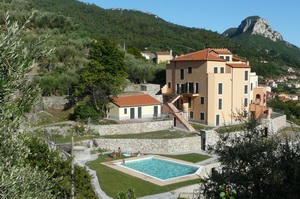
|
Italian
Riviera Homes
Specialising
in beautiful conversions of prominent old 'borghi' into luxury
properties set in their own grounds of vines, fruit and olive
trees. Finished properties are the result of a crafted restoration
of all genuine and authentic characteristics. Unique opportunities
in one of the Riviera's more sought after locations.
Click
the photo advert on the left for details. |
|
|
Adventure, activity and walking
holidays in Italy on the Italian Rivieras. Independent, escorted
and self guided walking holidays in Liguria, Italy - plus paragliding,
4x4 and skiing holidays. Come and discover the undiscovered and
allow yourself to be charmed by Italy's beautiful Ligurian Rivieras.
Visit and explore mountains, mediterranean rivieras and one of
Italy's lesser known regions - on foot, by 4x4, with paraglider
or on skis. |
|
Enjoy relaxed, independent walking
holidays in Italy along the Italian Rivieras using self-guided
itineraries. Explore the beautiful mediterranean countryside
and coastal mountains by foot taking in some of the regions most
famous and magnificent towns and coast - the Cinque Terre, Portofino,
Genova (Genoa), Santa Margherita, Rapallo, San Fruttuoso, Camogli,
Chiavari, Sestri Levante, Vernazza, Manarola, Riomaggiore, Monterosso
al Mare, Corniglia, Portovenere, Savona, Spotorno, Noli, Finale,
Alassio, Imperia, San Remo and it's national parks to name but
a few. |
Whatever you look for in the great
outdoors, the region of Liguria in northern Italy, is a paradise
for independent walking, hiking, mountain walking, coastal walking,
and simply exploring the regions characteristic seaside towns
and fishing villages - in spring, summer, autumn and winter.
Liguria, an intense flavour of Italy in one of Europe's most
unique 'sea and mountain' locations.
Xtrallusion offers a variety
of self-guided holidays, all year round. |
|
|

